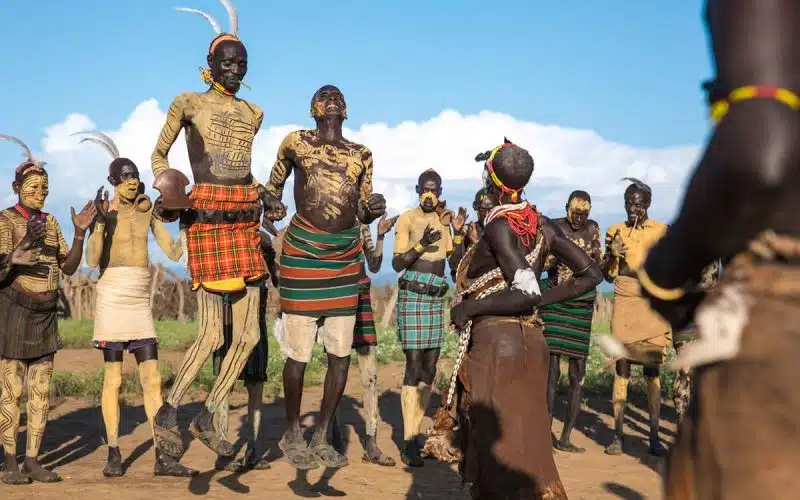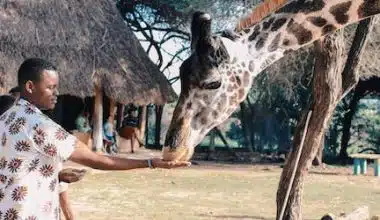In Ethiopia, a land of cultural richness, various tribes weave a colorful tapestry of unique identities, customs, and heritage. Ethiopia is a diverse country with numerous ethnic groups and tribes, each with unique cultural practices, traditions, and lifestyles. These tribes are known for their unique hairstyles, body decorations, and stick-fighting practices. Let’s delve into the rich culture and tradition of the Ethiopian tribes in Africa.
Ethiopian Tribes
Ethiopia is a diverse country, with numerous ethnic groups and tribes. Every tribe possesses a unique culture, traditions, and lifestyle, enhancing the country’s rich cultural tapestry.
Lists of Ethiopian Tribes
#1. Aari Tribe
The Aari tribe is located in the South Omo Zone region of southern Ethiopia, particularly around the town of Jinka.
#2. Arbore Tribe
The Arbore tribe is also found in the South Omo Zone region, near the town of Jinka. They are known for their unique cultural practices and colorful attire.
#3. Banna Tribe
The Banna tribe resides in the South Omo Zone region, close to the town of Jinka. They have distinct cultural traditions and are known for their body decorations and hairstyles.
#4. Dassanech Tribe
The Dassanech tribe is located in the South Omo Zone region, near the town of Jinka. They are traditionally pastoralists and have a rich cultural heritage.
#5. Hamer Tribe
The Hamer tribe is one of the most well-known tribes in Ethiopia. They inhabit the South Omo Zone region, with their main town being Turmi. The Hamer people are known for their unique hairstyles, body adornments, and bull-jumping ceremonies.
#6. Kara Tribe
The Kara tribe is situated in the South Omo Zone region, near the town of Jinka. They are known for their intricate body paintings and scarifications, which hold cultural significance.
#7. Mursi Tribe
The Mursi tribe is located in the Omo Valley and is known for its distinctive lip plates worn by women. They are also recognized for their warrior culture and participate in festive battles called “Dunga”.
#8. Nyangatom Tribe
The Nyangatom tribe is found in the South Omo Zone region, near the town of Jinka. They are traditionally pastoralists and have a rich cultural heritage.
#9. Tsemai Tribe
The Tsemai tribe resides in the South Omo Zone region, close to the town of Jinka. They have unique cultural practices and are known for their agricultural lifestyle.
#10. Suri Tribe
The Suri tribe is located in the more distant West Omo Zone. They are known for their body painting, elaborate hairstyles, and the practice of stick fighting as a rite of passage.
Distinct Features of Ethiopian Tribes
There are several different tribes in Ethiopia, each with unique characteristics. These are a few significant attributes of Ethiopian tribes.
#1. Housing and Architecture
Ethiopian tribes have unique housing styles and architectural practices. The types of dwellings vary depending on the tribe and the region they inhabit. For example, the Konso tribe is known for its stone-walled terraces and fortified villages, while the Afar tribe traditionally constructs dome-shaped huts made from woven materials.
#2. Food and Cuisine
Ethiopian tribes have diverse culinary traditions and food preferences. Each tribe has its traditional dishes, cooking methods, and ingredients. For instance, the Oromo tribe is known for their staple food called “injera,” a sourdough flatbread, whereas the Surma tribe is famous for their love of raw meat and milk products.
#3. Oral Traditions and Storytelling
Ethiopian tribes have a rich tradition of oral storytelling, passing down their history, myths, legends, and moral teachings through generations. Storytelling plays a vital role in preserving cultural heritage and transmitting knowledge within the tribe.
#4. Relationship with Nature
Ethiopian tribes have deep connections with their natural environment. Many tribes have traditional ecological knowledge and sustainable practices for resource management. They often rely on natural resources for their livelihoods and have developed unique methods for farming, hunting, fishing, and gathering.
Ethiopian tribes often have a strong sense of community and practice communal living. They have well-established social structures where cooperation, mutual support, and collective decision-making are valued. This sense of community strengthens their cultural identity and provides a support system within the tribe.
#6. Language and Communication
Ethiopian tribes often have their own languages or dialects, which contribute to their distinct identities. Many tribes maintain their own languages, which may differ from the official language of the country or region. This linguistic diversity is a reflection of the rich cultural heritage of the tribes.
#7. Traditional Attire
Ethiopian tribes have unique traditional attire that showcases their cultural identity. The clothing styles, colors, patterns, and accessories vary among different tribes. Traditional attire is often worn during special occasions, ceremonies, or as part of everyday life.
#8. Body Decorations
Body decorations, such as scarifications, body paintings, and elaborate hairstyles, are common among Ethiopian tribes. These adornments hold cultural significance and are often used to express identity, beauty, or social status.
#9. Livelihood and Occupation
Ethiopian tribes engage in various livelihood activities based on their geographical location and cultural practices. Some tribes are pastoralists, relying on livestock herding, while others practice agriculture or fishing. The diverse environments in Ethiopia contribute to the different livelihood strategies of the tribes.
Ethiopian tribes have unique social structures and systems of governance. They often have customary leaders and organizations that represent their interests and maintain their distinct identities. These social structures play a crucial role in decision-making, conflict resolution, and the preservation of cultural traditions.
#11. Beliefs and Spirituality
Ethiopian tribes have diverse belief systems and spiritual practices. Some tribes follow traditional animistic religions, while others have adopted Christianity or Islam. These belief systems shape their worldview, rituals, and interactions with the natural environment.
Cultural Practices of Ethiopian Tribes
Ethiopian tribes have diverse cultural practices that vary between regions, religions, and ethnic groups. The different cultural practices of Ethiopian tribes include
#1. Ethnic Diversity
Ethiopia is home to over 80 different ethnic groups, each with its own cultural practices and traditions. The largest ethnic groups include the Oromo, Amhara, Somali, Tigray, and Sidama, among others.
#2. Traditional Clothing
Ethiopian tribes have distinct traditional clothing styles. The attire varies based on the tribe and occasion. For example, the Amhara tribe is known for their white cotton clothing, while the Oromo tribe has a tradition of wearing colorful garments called “gabi” or “wollo7”.
#3. Ceremonies and Festivals
Ethiopian tribes celebrate various ceremonies and festivals throughout the year. These events often involve music, dance, feasting, and religious rituals. Examples include the Timket festival, the Meskel festival, and the Irreecha festival, which are celebrated by different tribes.
#4. Religious Practices
Ethiopian tribes follow different religious beliefs, including Christianity, Islam, and traditional animistic religions. Each tribe may have its own unique religious practices, rituals, and ceremonies associated with their belief systems.
#5. Rites of Passage
Ethiopian tribes have specific rituals and ceremonies to mark important life transitions such as birth, initiation into adulthood, marriage, and death. These rites of passage often involve traditional practices, songs, dances, and symbolic rituals that vary among tribes.
#6. Art and Crafts
Ethiopian tribes are known for their artistic expressions and craftsmanship. They create various forms of art, including pottery, weaving, basketry, woodcarving, and metalwork. These artistic traditions are passed down through generations and hold cultural significance.
#7. Traditional Music and Dance
Music and dance play a vital role in the cultural practices of Ethiopian tribes. Each tribe has its unique musical styles, instruments, and dance forms. Traditional music and dance are often performed during celebrations, ceremonies, and social gatherings.
#8. Cultural Beliefs and Taboos
Ethiopian tribes have specific cultural beliefs, taboos, and social norms that guide their behavior and interactions. These beliefs may include ideas about respect for elders, hospitality, gender roles, and the importance of community and kinship ties.
#9. Traditional Healing Practices
Ethiopian tribes often have traditional healing practices that involve herbal medicine, spiritual rituals, and the use of traditional healers. These practices are deeply rooted in the cultural beliefs and knowledge systems of the tribes.
#10. Cultural Cuisine
Ethiopian tribes have their own culinary traditions and food preferences. Each tribe has its own traditional dishes, cooking methods, and ingredients. Ethiopian cuisine is known for its unique flavors, spices, and communal eating style, often involving injera (sourdough flatbread) and various stews.
Challenges of Ethiopian Tribes
Ethiopian tribes face various challenges, which can be attributed to factors such as historical conflicts, ethnic tensions, political instability, environmental issues, and socio-economic disparities.
#1. Conflict and Ethnic Tensions
Ethiopia has experienced conflicts and ethnic tensions between different tribes and ethnic groups. These conflicts can arise due to competition over resources, historical grievances, political power struggles, or disputes over land and borders.
#2. Displacement and Refugee Crisis
Internal displacement and refugee crises have been prevalent in Ethiopia, particularly in regions affected by conflicts and violence. Displaced individuals and refugees often face challenges related to access to necessities, shelter, healthcare, and education.
#3. Political Instability
Ethiopia has faced periods of political instability, including changes in government and governance structures. These transitions can create uncertainties and challenges for tribes, especially in terms of representation, resource allocation, and decision-making processes.
#4. Environmental Issues
Environmental challenges, such as drought, deforestation, and land degradation, affect many Ethiopian tribes. These issues can impact livelihoods, food security, and access to natural resources, particularly for tribes dependent on agriculture, pastoralism, and fishing.
#5. Socio-Economic Disparities
Ethiopian tribes often face socio-economic disparities, including limited access to education, healthcare, clean water, and infrastructure. Economic inequalities can hinder development opportunities and perpetuate poverty within tribal communities.
#6. Loss of Cultural Heritage
Rapid modernization, globalization, and external influences pose challenges to the preservation of traditional cultural practices and languages. The younger generations within tribes may face pressure to assimilate into mainstream society, leading to a potential loss of cultural identity.
#7. Limited Access to Services
Some tribes, particularly those living in remote or marginalized areas, may have limited access to essential services such as healthcare, education, and transportation. This lack of access can further exacerbate socio-economic disparities and hinder development.
#8. Land and Resource Rights
Land tenure and resource rights can be a challenge for Ethiopian tribes, especially in areas where there are competing interests for land and natural resources. Disputes over land ownership and resource extraction can lead to conflicts and tensions between tribes and other stakeholders.
#9. Border Conflicts
Some Ethiopian tribes reside in borderland areas, which can lead to conflicts and tensions between neighboring communities. Border disputes and competition over resources can exacerbate challenges related to economic development and social cohesion.
#10. Infrastructure and Connectivity
Limited access to infrastructure, including roads, electricity, and communication networks, can hinder the development and connectivity of tribal communities. This can impact access to essential services, economic opportunities, and social integration.
How Many Tribes Are In Ethiopia?
Ethiopia is home to over 80 different ethnic groups, each with its unique cultural practices and traditions. Some of the notable tribes in Ethiopia include the Amhara, Oromo, Tigray, Sidama, Afar, Somali, Mursi, and Hamer tribes. These tribes have distinct languages, traditions, and ways of life, contributing to the rich cultural diversity of the country.
Which Tribe Is Beautiful In Ethiopia?
Several Ethiopian tribes are often recognized for their unique beauty and cultural practices. The Hammer, Mursi, Suri, and Bodi tribes stand out for their distinctive aesthetics. The Hamer tribe is known for its traditional attire and intricate hairstyles, while the Mursi tribe is famous for the wooden lip plates worn by women. The Suri tribe is admired for their body painting, scarification patterns, and elaborate hairstyles, while the Bodi tribe has a unique beauty standard that celebrates being overweight.
What Is The Native Tribe of Ethiopia?
Ethiopia is home to various native tribes, each with its own distinct cultural heritage and practices. Some of the notable native tribes in Ethiopia include the Hamer, Mursi, Suri, Bodi, Amhara, Oromo, Tigray, Sidama, Afar, and Somali tribes. These tribes have unique traditions, languages, and ways of life that contribute to the rich cultural diversity of Ethiopia. The Hamer tribe is known for its traditional attire and vibrant beadwork, while the Mursi tribe is famous for the wooden lip plates worn by women. The Suri tribe is admired for its body painting, scarification patterns, and elaborate hairstyles. The Bodi tribe has a unique beauty standard that celebrates being overweight.
What Was The Name Of The Tribe To The North Of Ethiopia?
The tribe to the north of Ethiopia is the Tigray tribe. The Tigray tribe is situated in the highlands of northern Ethiopia, in a region called Tigray, near present-day Eritrea. The Tigray people have their distinct language, cultural practices, and traditions.
What Is The Biggest Tribe In Ethiopia?
The Oromo tribe is considered the largest ethnic group in Ethiopia. They are estimated to make up a significant portion of the country’s population, with at least 20 million people. The Oromo people have a rich cultural heritage and have played a significant role in Ethiopian history and politics.
What Are The Two Main Tribes In Ethiopia?
The two main tribes in Ethiopia are the Amhara and the Oromo tribes. These two tribes, along with the Tigray and Somali tribes, make up the majority of the Ethiopian population, accounting for three-quarters of the total population. The Amhara tribe has a population of around 17 million and has a long history in Ethiopia, dating back over 2,000 years. The Oromo tribe is considered the largest ethnic group in Ethiopia, with an estimated population of over 20 million. These two tribes have played significant roles in Ethiopian history and culture.
Conclusion
Ethiopian tribes have unique characteristics such as unique housing styles, diverse culinary traditions, oral traditions, deep connections with nature, and strong social cohesion. They have unique methods for farming, hunting, fishing, and gathering and rely on natural resources for livelihoods. Ethiopian tribes have diverse cultural practices, varying between regions, religions, and ethnic groups. Political instability, environmental issues, socio-economic disparities, loss of cultural heritage, and limited access to services further exacerbate some challenges faced by Ethiopian tribes.
- TRIBES IN AFRICA: Unveiling the Rich Traditions and Heritage
- HIMBA TRIBE: Discover the Traditions and Beliefs of the Himba Tribe
- The Rich Cultural Heritage of Himba Tribe Women
- INDUS RIVER VALLEY CIVILIZATION: Everything You Need To Know
- SAN PEOPLE OF AFRICA: History & Rich Cultural Heritage






